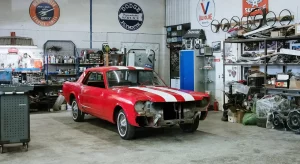PCV is a small yet significant part of a gasoline engine that most people do not know. It is known for failing, which is why every car owner must know the bad PCV valve symptoms.
PCV is a small part but holds huge importance, as any problem with it can cause your engine to break down.
The quality of the PCV in your engine and its chances of breaking down depends on how well-maintained your automobile is.
PCV system is what ensures your ride does not emit harmful pollutants into the environment. Thus, it is not only crucial for your smooth ride but also to save the environment.
But there are times when this small part might start acting out. Suppose you do not take care of the issue immediately. In that case, the delay will only leave you with a busted engine and a more expensive matter to handle.
We understand it is hard to take care of the parts you might not see regularly. But what if we tell you certain indicators will let you know if your PCV system is working or not?
This article talks about the PCV, its working, significance, bad PCV valve symptoms & more.
We ensure that by the time you are done reading this article, you will be able to identify the symptoms of a clogged PCV valve easily.
So, let us start and learn how to take better care of your engine’s small eco-friendly part.
What Is A PCV Valve?
PCV is an acronym used for “Positive Crankcase Ventilation.” It is a one-way valve attached to the crankcase and is a kind of emission control device.
It is a ventilation system that helps in removing unwanted gases from the crankcase.
Your car’s crankcase holds its motor oil and is located at the bottom of the engine. Crankcase produces gases as a byproduct whenever the engine burns fuel.
Most such waste gases escape the engine via your tailpipe. However, some sneak through your pistons into the crankcase filled with motor oil.
As soon as an unprecedented amount of gas enters the crankcase, it combines with the engine oil and forms a thick, foul-smelling, greasy sludge.
Suggestion: 7 Best Car Seats For 4-Year-Olds Review A Parent Can Buy
It is bad as this sludge can damage your engine components and even block the engine system’s multiple oil channels.
But this all is avoided by the automotive-emission control valve. It allows all the gases entering the crankcase to return to your engine and burn.
What Is The Objective Of A PCV Valve?
As discussed earlier, the positive crankcase ventilation valve in your car engine is a one-way check valve controller that is used to hold the passage of waste gases.
One end of this crucial valve is connected to the manifold vacuum hose of your engine. At the same time, the other is attached to your engine’s intake valve cover.
An automotive-emission control valve controls the emissions of your automobile.
It takes the waste gases produced by the crankcase and redirects them back into your engine’s combustion chambers.
This way, the waste gases are safely burned again in another engine cycle without harming your vehicle or the environment. PCV valve technically makes your car’s emissions cleaner or pollutant free.
In simpler terms,
- The valve uses the engine vacuum to pull the waste gases out of your crankcase.
- The valve then pushes those gases into the intake manifold and back to the combustion chambers, where they are re-burned to eliminate harmful pollutants.
Understand that the gases can exit the crankcase via the auto-emission control valve but can not flow back into it. This way, the crankcase is safe from developing engine-damaging oil sludge.
PCV ensures these gases flow into your engine’s intake manifold and are burnt completely during combustion.
In addition, a well-maintained PCV valve can offer your engine a little extra boost by helping the crankcase & piston rings to improve your chamber’s compression.
What Are The 12 Most Common Symptoms Of A Bad PCV Valve?
The automobile control lid is a small, almost invisible engine part usually made of plastic. The valve is located at the bottom of the engine, which is why most people are unaware of it.
However, this tiny part plays a big role in the eco-friendly working of your engine.
A positive crankcase ventilation valve in your engine ensures that your vehicle emits the cleanest emissions with the least harmful pollutants.
So, if you want to ensure you do not get fined for having a polluting ride, you need to take good care of your PCV valve.
However, it is common for positive crankcase ventilation to fail after years of usage. Here failing down is not the problem but the fact that most car owners do not know it and end up with more severe damage.
You can avoid this by looking for the various symptoms of a malfunctioning emission-control device.
It is not physically possible to always have a look at your PCV valve. Still, it is possible to ensure whether it is working properly or not while driving.
Related: 2024 Dodge Viper Review, Price Specification and Released Date
This section has the 12 most prevalent symptoms of a clogged emission control valve. Keep your eyes on them, and you will never let your bad situation worsen.
1. Check The Engine Light
One of the most common signs of a malfunctioning PCV valve is the lighten-up check engine light on your dashboard.
Usually, there are several reasons why your check engine light must be on. Check the engine control unit’s fault code using an OBD2 scanner to ensure it is because of your automotive emission control valve.
However, remember that some older car valves installed without an electronically controlled engine will not showcase this symptom.
2. Poor Fuel Economy
Another sign of a clogged PCV valve is sudden degradation in your vehicle’s fuel economy.
As stated, the automobile control lid allows residual air into your engine while it is open. This process helps your engine control unit in adjusting the air & fuel mixture adequately.
However, with a jammed or closed valve, the required amount of air will not reach the engine, resulting in poor fuel efficiency.
It leads to reduced fuel efficiency and raises the level of emissions produced by your car.
3. Rough Idle or Increased Idle RPM
The PCV valve works to control the airflow between the intake manifold & crankcase. It is the reason why a broken automotive-emission control valve often shows symptoms similar to an intake air leak.
Suppose you find your idle RPM getting too high and notice other strange occurrences like very rough idle. In that case, it is better that you get your attention to the emission control valve first.
4. Bad Filter
A bad PCV valve can lead to the contamination of the air filter. It will lead to the breather element getting polluted with oil & hydrocarbons.
This mostly happens due to the rise in crankcase pressure which forces the water vapor in your breather element.
Then the combination of water and gas leads to the buildup. This buildup further leads to a sudden drop in your vehicle’s fuel economy.
5. Lean or Rich Mixture
The PVC valve in your engine regulates the airflow across your crankcase & intake manifold. Thus, the symptoms of a broken valve may look similar to the intake air leak.
Your mixture becomes lean or rich with the wrong air and fuel mixture proportion.
Don’t Miss To Checkout: 7 Best Dual Action Polisher For Beginners Review
If the air & fuel mixture becomes lean, you will feel similar symptoms as from a lean mixture. And if it is a rich mixture, you will see your car emitting more grey or white smoke than usual, plus the smell of petrol.
Of the two, the lean mixture is more difficult to find and often causes misfires.
6. Engine Misfires
Because a faulty lean or rich mixture is a possibility due to a faulty PCV valve, there are chances of your engine misfiring on both idle and acceleration.
The excessive lean mixture causes the engine cylinders not to fire up or charge up correctly, leading to misfires.
Also, the fuel can spark extinguishing if the mixture is excessively rich, leading to an engine misfire.
7. Weird Engine Noises
Suppose you find your engine making unusual or weird sounds like whirring noises when you are riding. In that case, it is another symptom of a bad PVC valve.
A whistling noise from under the hood is the trapped air trying to escape from the valve.
Always pay attention to sounds other than your obvious engine noises. Any occurrence of them is an indication of an issue.
8. Unrefined Acceleration
A faulty PCV valve causes the wrong proportion of air & fuel mixture, which also causes unrefined acceleration.
You can feel your car’s rough acceleration on both high & low RPMs.
Also, it is hard to diagnose a broken valve controlling emissions on higher RPMs in many cars. So, whenever you have a sudden splurge in your RPM rating, consider the broken PCV valve.
9. Oil Leaks
The engine oil leaking out of the blue is another unavoidable symptom of a malfunctioning PCV valve.
This valve is an escape route for gases from the engine crankcase. However, if it is faulty, it leads to gas accumulation within the crankcase and raises its internal pressure.
If the pressure passes the minimum threshold, it leads to the leaking of engine oil through multiple seals & gaskets.
So, if you find several sudden oil leaks in your car, it is an indication that you should take a look at your positive crankcase ventilation system.
10. Increased Oil Consumption
A broken PCV valve also leads to a sudden rise in the oil consumption of your car.
Usually, one needs to refill the engine oil tank once every two to three months. Still, if you find yourself doing it more often and see no obvious reasons, the PCV system is your culprit.
11. Engine Stalling
A failed PCV valve either leads to a closed plunger or a completely open one.
When the valve plunger remains open, it leads to a high volume of air entering the combustion cylinders. It results in lean air & fuel mixture, meaning engine cylinders have more air than fuel.
This entire commotion leads to your engine stalling or idling poorly.
12. Altered Exhaust Smoke
A jammed-shut PCV valve can increase the pressure inside your crankcase. It can lead to oil seeping out from the seals and moving up to your combustion chambers.
If this happens, the engine oil begins to burn and change the color of your exhaust emission.
Generally, the exhaust gas of a healthy car is less smoky and has an almost transparent hue.
However, with a poorly working emission control system, your exhaust gas will be smokier than normal and can have a black, white, or bluish hue.
The blue flames coming out of your exhaust pipe are a clear indication of your engine eating up oil. So, if you encounter altered exhaust smoke, do not overlook it.
How To Know If PCV Valve Is Bad & Test By Yourself In 4 Easy Steps?
If you want to save yourself hundreds of dollars to clear your doubt regarding whether the PCV valve of your engine is causing the commotion in your ride or not, you can do it all by yourself.
An automotive-emission control valve generally holds little importance for many auto manufacturers & they do not have PCV system maintenance. It is one of the reasons why many car owners do not know about it.
Many car enthusiasts recommend that servicing the PCV valve system every 35,000 miles is a good idea.
However, we believe a more frequent system inspection will keep you updated. It also helps in preventing severe engine damage & high repair costs.
Here we have an easy step-by-step process that will help you test your automobile control lid and determine if it is functioning well or not.
A. Locate The PCV Valve
The first step in examining your PCV valve is to locate it & its related component within your engine.
The place of the system may vary depending on the model you own. In some, it is on a rubber grommet on the valve cover, it is to the side of the engine block, & in others, it is on a breather opening around the intake manifold.
Popular For You: 7 Best Shocks And Struts For Mustang GT Review
Remember that some latest models do not have a PCV valve. Instead, they have a simple vacuum hose from the valve cover to an air inlet duct.
In such a case, you should also check the restrictor, hoses, & other parts.
Suppose you are having trouble finding the PCV system look into the user’s manual of your car. Also, you can buy a service manual for your model as it contains simple ways for easy maintenance & repair tasks.
B. Check The PCV Valve System
After locating the valve system, the next step is to inspect it. Locating is a lengthy step; checking the system will not take much of your time.
- Check the system parts for any damage. Look out for the rubber components like O-rings, grommets & hoses. They will swell and turn hard & brittle due to constant exposure to high temperatures and even begin to leak. Check & replace these components as required.
- Disconnect the valve & system hoses and visually inspect them. If the hoses are filled with slime, clean them with a solvent. Also, replace the valve.
- If you own a simple & inexpensive valve, you can replace it whenever you have professional servicing. However, if you want something more strong & long-lasting, other valves come with heating elements & cost more. No matter which type you choose, always go for a quality product.
- In some engines, there is a mesh filter under the valve. And the manufacturers of these engines recommend replacing the filter every 30,000 miles.
- Many PCV valves come with a spring-loaded device. So, when checking, shake the removed valve. If it does not rattle, you need to replace it immediately.
- If your emission valve is electrically heated, you need to check its heater coil using an ohmmeter. It is okay for the coil to have some resistance.
If the resistance is infinite, you need to replace the valve. We recommend visiting a mechanic.
C. Testing A PCV Valve During Engine Running
Apart from visually inspecting your valve system, you must test it when your engine is running.
It is a good alternative step if you are unable to access your PCV valve or want to ensure if it is creating an issue in your engine or not.
- Testing For Vaccum Using RPMs
- Begin your engine. Let it idle for around 15-20 minutes. Here you want to warm it up to operating temperature.
- After warming up, open the hood, disconnect the valve from the valve cover, and block the end of the valve with your finger.
- You should feel a vacuum from the system sucking at your fingertip.
- Also, you will notice a momentary idle speed drop of about 40 to 80 RPMs
- If you do not feel any vacuum at your fingertip, there is an issue with the valve.
D. Finding Moisture In The PCV System
After removing the automobile control lid, you may find traces of milky brown fluid in the valve & hoses of the system.
Do not get alarmed, as a milky substance generally indicates the moisture in the oil.
There is an accretion of moisture in the oil due to:
- Frequent short trips
- If you take frequent short trips, usually under 10 miles, you can solve the issue by replacing the engine oil more frequently.
- Coolant leaking into the engine
- If you drive only long miles and still find moisture in the oil, there is a coolant leak. Take your car to a mechanic to dodge any further damage.
- A restricted fresh air flow in the system
- There may be debris deposits on the filter, which normally prevents fresh air from getting into the engine. Clean the filter or replace it. A mechanic can assist you with the job if you cannot do it yourself.
When Should I Replace My PCV Valve?
A positive crankcase ventilation valve unlike your car’s engine oil or battery needs to be replaced within a particular time.
It is a small yet crucial component of your engine that needs no replacement as long as it works properly.
However, it is not immune to the issues. The gases moving through the valve may leave traces of oil, and they can clog the valve.
Popular Post: 9 Best Electric Paint Sprayer For Cars – Buyer’s Guide
If this continues can lead to valve failure and, in severe cases, damage to the engine.
So, the best way to tackle it is to look out for bad PCV valve symptoms, like:
- Your check engine light is on
- Noticeable oil leaks
- Blown-out seals or gaskets
- Sludge around the engine
- Whistling noises coming from the engine
If you find any of these symptoms within your emission control valve system, you need to replace it immediately.
Any wait on your part can lead to more damage and eventually the engine breakdown.
It will not only be inconvenient but expensive too.
Symptoms Of A Clogged PCV Valve & How To Replace The PCV Valve By Yourself?
PCV valves are not present in all modern engines. Some have it, while others don’t.
Suppose your vehicle does have an auto-emission control valve, and you encounter your check engine light on, the engine running, or idling rough. In that case, it indicates that your valve system is having some issues.
Inspecting your valve system will let you know if it is getting blocked by the sludge deposits, jammed in a wide-open setting, or more.
You can perform the inspection yourself and if you find the said issues, replace the valve immediately.
Here we have the step-by-step instructions for uninstalling your PCV valve to examine, clean, or change it.
– Step-1
Locate your PCV valve, release its hose clamp or remove the tiny L-shaped cover from its end.
– Step-2
Disconnect the valve. If a rubber grommet secures your valve, it will be easier to remove.
If removing from hands is tough, use a wrench to get the job done.
– Step-3
After the removal, inspect the hose, clamps & grommets.
Take off the hose and blow it out. You should change it if it is stiff, dried, spongy, mushy, or clogged with sludge.
Also, change the grommets & clamps if they are rusted or seem degraded from their usual form.
– Step-4
Reinstall the PCV valve. If your valve system requires screwing in, it is better to do it manually to avoid damage.
Ensure that the valve is well installed but avoid over-tightening.
– Step-5
Firstly, mend the hose connection to your PCV valve. Then start your engine and examine it for leaks around the valve system.
If there is nothing, it means your replacement valve is perfectly secured.
What Is The Replacement Cost Of PCV Valve?
The average cost for replacing a PCV valve varies from $70 to $300, depending on your model and the labor charges of the respective mechanic shops.
In simpler terms, a new positive crankcase ventilation valve will cost you between $20 and $70. The labor charges for replacing it at a professional mechanic workshop will cost between $40 and $300.
The replacement cost of your PCV valve is highly affected by the model of your car. A complex engine will cost you more than the other.
Suggestion: 7 Best Cold Air Intake For Chevy Silverado 1500 Reviews
If you think you can do the replacement task yourself, you can save hundreds of dollars on labor costs.
However, if your PCV valve is located under the manifold, doing the replacement yourself will be difficult.
In such scenarios going for a mechanic will be your best bet.
Understand that replacing this valve in older cars is often easy as the engines have simple composition. In contrast, the same task is difficult in modern cars with complex engine buildup.
FAQs On What Happens When A PCV Valve Goes Bad
What happens when a PCV valve goes bad?
If the PCV valve of your engine goes bad, you will hear whistling noise coming under the hood every time your engine runs.
Also, you will see a sudden drop in fuel efficiency, sudden engine misfires, and experience unrefined acceleration in your car.
Is it attainable to cleanse the PCV valve of your car?
YES. If the part is only clogged, cleaning it is a simple task. It is common for gas impurities to stick to the valve and block the pathway.
PCV valves are quite cheap. So, whenever you are there to clean one, we recommend you replace it as it avoids the problems of its spring mechanism breaking down.
How often should I change my PCV valve?
There is no specific period to change the automotive control lid. It is considered insignificant by many manufacturers that they do not include it as a part that needs extra care.
Car owners replace it whenever they encounter any symptom related to it.
If you own a good quality valve, it can last for a long time, while a cheap one will demand frequent change.
Is it secure to drive with a defective PCV Valve System?
NO. The PCV valve might seem like an insignificant engine part, but it affects the engine’s working highly.
Running your vehicle on a faulty valve can lead to engine damage. And if you drive continuously for hours with such a valve, it can have severe consequences.
Can a faulty PCV valve burn oil?
A PCV valve does not technically burn oil. Still, under the engine’s high pressure, it may cause oil leaks from the significant engine gaskets.
It increases oil consumption, and you might see oil patches around your parked car.
The efficient way to tackle the situation would be to call a mechanic and have them take a look at your ride.
How to know if the PCV valve is bad?
PCV Valve is a small part of your engine generally placed in the bottom parts of the engine around or under the intake manifold.
Suppose you find frequent oil leaks, increased oil consumption, engine stalling, and altered exhaust smoke coming out of your car.
In that case, it is a clear sign that the valve of your ride has gone bad and needs immediate replacement.
Conclusion
A PCV Valve System might be small but is a crucial part of your engine. Its malfunctioning can lead to severe damage. Thus it is better if you learn about bad PCV valve symptoms and how to tackle them for your good.
The article covers the most prominent symptoms and a simple guide that helps you inspect & replace your bad PCV valve.
We hope you enjoyed your read. Also, what are the most common symptoms you encounter with your faulty PCV valve?
Discover more from Locar Deals
Subscribe to get the latest posts to your email.







